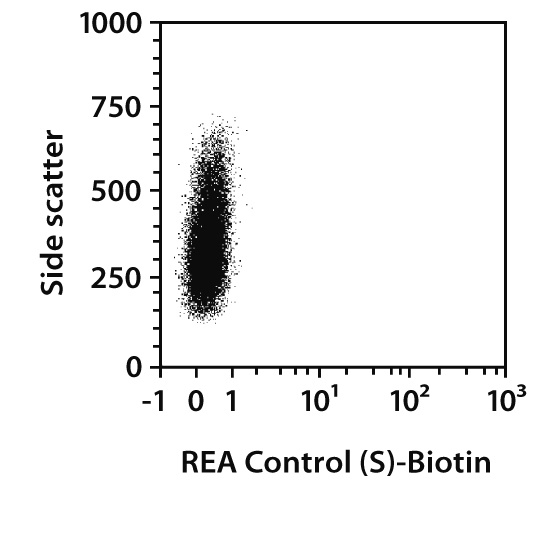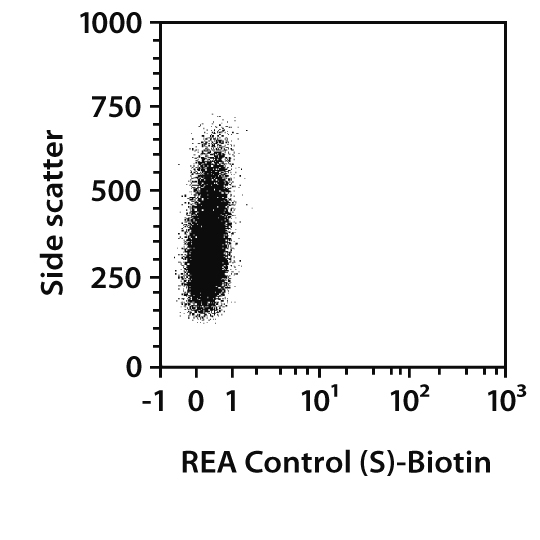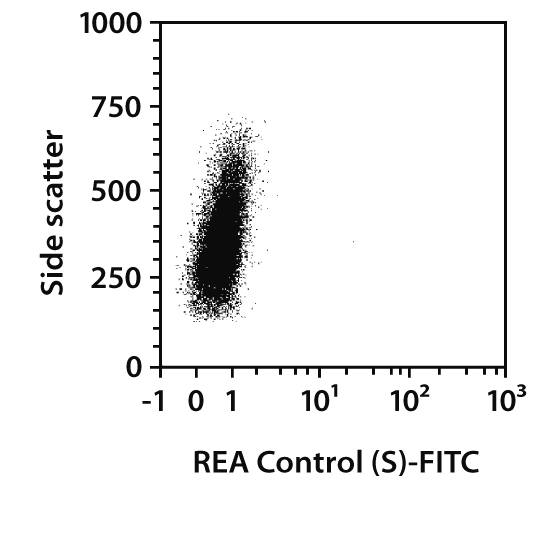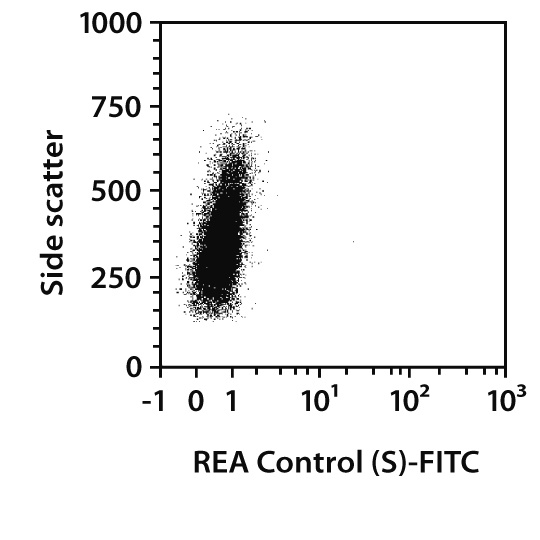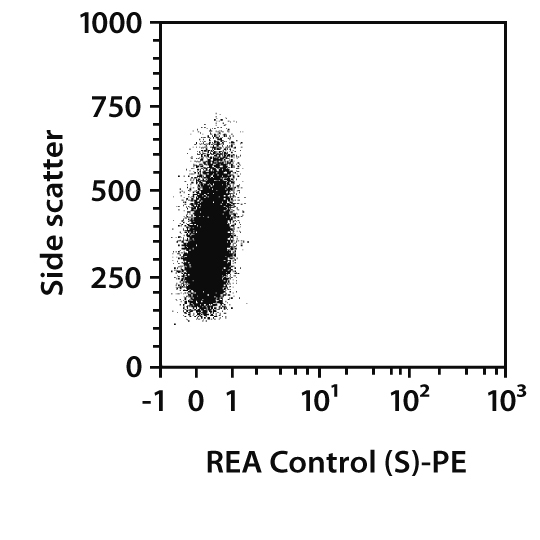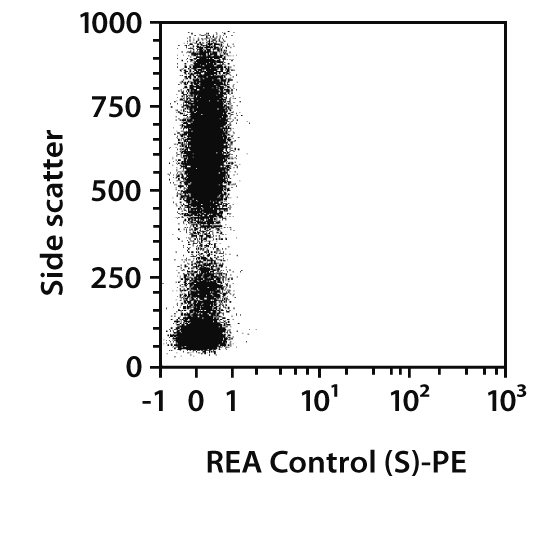Recombinant antibody
Code: 130-104-400
Overview
Clone REA296 recognizes MHC class II-associated invariant chain (Ii)-derived peptide (CLIP) complexes. MHC class II αβ heterodimers associate early during biosynthesis with a type II membrane protein, the invariant chain (Ii). The invariant chain serves as a chaperone for MHC II molecules and mediates trafficking to the endosomal pathway. In the endosomal pathway Ii is sequentially degraded, leaving a residual CLIP in the peptide-binding groove of MHC II. In presence of antigen peptide fragments, HLA-DM then binds to the MHC II molecule, releasing CLIP and allowing peptides to bind. REA296 detects HLA class II-positive cells which have impaired HLA-DM activity, and tumor cells that have escaped immuno-surveillance by CD4-positive T cells.
Additional information: Clone REA296 displays negligible binding to Fc receptors.
Alternative names
Class II-associated invariant chain peptide, DHLAG, HLADG, II, Ia-GAMMA, CD74Specifications
- Human : 0
- Biotin : 0
- 100 tests : 0
- 1 mL : 0
- Recombinant Human IgG1 : 0
Code: 130-104-418
Overview
Clone REA296 recognizes MHC class II-associated invariant chain (Ii)-derived peptide (CLIP) complexes. MHC class II αβ heterodimers associate early during biosynthesis with a type II membrane protein, the invariant chain (Ii). The invariant chain serves as a chaperone for MHC II molecules and mediates trafficking to the endosomal pathway. In the endosomal pathway Ii is sequentially degraded, leaving a residual CLIP in the peptide-binding groove of MHC II. In presence of antigen peptide fragments, HLA-DM then binds to the MHC II molecule, releasing CLIP and allowing peptides to bind. REA296 detects HLA class II-positive cells which have impaired HLA-DM activity, and tumor cells that have escaped immuno-surveillance by CD4-positive T cells.
Additional information: Clone REA296 displays negligible binding to Fc receptors.
Alternative names
Class II-associated invariant chain peptide, DHLAG, HLADG, II, Ia-GAMMA, CD74Specifications
- Human : 0
- Biotin : 0
- 30 tests : 0
- 0.3 ml : 0
- Recombinant Human IgG1 : 0
Code: 130-104-401
Overview
Clone REA296 recognizes MHC class II-associated invariant chain (Ii)-derived peptide (CLIP) complexes. MHC class II αβ heterodimers associate early during biosynthesis with a type II membrane protein, the invariant chain (Ii). The invariant chain serves as a chaperone for MHC II molecules and mediates trafficking to the endosomal pathway. In the endosomal pathway Ii is sequentially degraded, leaving a residual CLIP in the peptide-binding groove of MHC II. In presence of antigen peptide fragments, HLA-DM then binds to the MHC II molecule, releasing CLIP and allowing peptides to bind. REA296 detects HLA class II-positive cells which have impaired HLA-DM activity, and tumor cells that have escaped immuno-surveillance by CD4-positive T cells.
Additional information: Clone REA296 displays negligible binding to Fc receptors.
Alternative names
Class II-associated invariant chain peptide, DHLAG, HLADG, II, Ia-GAMMA, CD74Specifications
- Human : 0
- FITC : 0
- 100 tests : 0
- 1 mL : 0
- Recombinant Human IgG1 : 0
Code: 130-104-419
Overview
Clone REA296 recognizes MHC class II-associated invariant chain (Ii)-derived peptide (CLIP) complexes. MHC class II αβ heterodimers associate early during biosynthesis with a type II membrane protein, the invariant chain (Ii). The invariant chain serves as a chaperone for MHC II molecules and mediates trafficking to the endosomal pathway. In the endosomal pathway Ii is sequentially degraded, leaving a residual CLIP in the peptide-binding groove of MHC II. In presence of antigen peptide fragments, HLA-DM then binds to the MHC II molecule, releasing CLIP and allowing peptides to bind. REA296 detects HLA class II-positive cells which have impaired HLA-DM activity, and tumor cells that have escaped immuno-surveillance by CD4-positive T cells.
Additional information: Clone REA296 displays negligible binding to Fc receptors.
Alternative names
Class II-associated invariant chain peptide, DHLAG, HLADG, II, Ia-GAMMA, CD74Specifications
- Human : 0
- PE : 0
- 30 tests : 0
- 0.3 ml : 0
- Recombinant Human IgG1 : 0
Code: 130-104-420
Overview
Clone REA296 recognizes MHC class II-associated invariant chain (Ii)-derived peptide (CLIP) complexes. MHC class II αβ heterodimers associate early during biosynthesis with a type II membrane protein, the invariant chain (Ii). The invariant chain serves as a chaperone for MHC II molecules and mediates trafficking to the endosomal pathway. In the endosomal pathway Ii is sequentially degraded, leaving a residual CLIP in the peptide-binding groove of MHC II. In presence of antigen peptide fragments, HLA-DM then binds to the MHC II molecule, releasing CLIP and allowing peptides to bind. REA296 detects HLA class II-positive cells which have impaired HLA-DM activity, and tumor cells that have escaped immuno-surveillance by CD4-positive T cells.
Additional information: Clone REA296 displays negligible binding to Fc receptors.
Alternative names
Class II-associated invariant chain peptide, DHLAG, HLADG, II, Ia-GAMMA, CD74Specifications
- Human : 0
- PE : 0
- 30 tests : 0
- 0.3 ml : 0
- Recombinant Human IgG1 : 0
Code: 130-104-362
Overview
Clone REA166 recognizes the human glycoprotein A repetitions predominant (GARP) antigen, a 80 kDa type I membrane glycoprotein which belongs to the family of leucine rich repeat proteins. Expression of GARP protein is found on megakaryocytes, platelets, and activated regulatory T cells (Treg cells). GARP has been found to be associated with latency associated peptide (LAP), the prodomain responsible for conferring latency to non-active TGF-β. Thus, GARP as a latent TGF-β–binding protein (LTBP) regulates the surface expression of TGF-β and serves as a carrier of LAP, at the cell surface, to immune response active sites, where TGF-β is eventually activated and released to exert further physiological functions such as differentiation of regulatory T cells.
Additional information: Clone REA166 displays negligible binding to Fc receptors.
Alternative names
LRRC32, D11S833E, Glycoprotein A repetitions predominant (GARP)Specifications
- Human : 0
- Biotin : 0
- 30 tests : 0
- 0.3 ml : 0
- Recombinant Human IgG1 : 0
Code: 130-104-544
Overview
Clone REA303 recognizes HLA-DQ, an αβ heterodimer of the MHC class II type. Expressed on the surface of most nucleated cells, MHC class II molecules play an important role in the immune system. They are essential in the defense against infection and are a main consideration in transplantation medicine. In addition to presenting antigenic peptides from predominantly extracellular sources to CD4
+
T cells, MHC class II molecules also mediate the thymic selection of T helper cells. MHC class II molecules consist of an α and β chain and are transported to endosomal-lysosomal compartments by the invariant chain. In humans, MHC class II molecules are encoded by three different loci, HLA-DR, -DQ, and -DP, which display 70% similarity to each other. Both chains of HLA-DQ are polymorphic. Despite the essential function of MHC class II molecules in immune defense against pathogens, some alleles are frequently linked to immune diseases. Two autoimmune diseases in which HLA-DQ is involved are coeliac disease and diabetes mellitus type 1.
Additional information: Clone REA303 displays negligible binding to Fc receptor
Alternative names
HLA-DQA1, HLA-DQA2, HLA-DQB1, HLA-DQB2Specifications
- Human : 0
- Biotin : 0
- 30 tests : 0
- 0.3 ml : 0
- Recombinant Human IgG1 : 0
Code: 130-104-496
Overview
Clone REA303 recognizes HLA-DQ, an αβ heterodimer of the MHC class II type. Expressed on the surface of most nucleated cells, MHC class II molecules play an important role in the immune system. They are essential in the defense against infection and are a main consideration in transplantation medicine. In addition to presenting antigenic peptides from predominantly extracellular sources to CD4
+
T cells, MHC class II molecules also mediate the thymic selection of T helper cells. MHC class II molecules consist of an α and β chain and are transported to endosomal-lysosomal compartments by the invariant chain. In humans, MHC class II molecules are encoded by three different loci, HLA-DR, -DQ, and -DP, which display 70% similarity to each other. Both chains of HLA-DQ are polymorphic. Despite the essential function of MHC class II molecules in immune defense against pathogens, some alleles are frequently linked to immune diseases. Two autoimmune diseases in which HLA-DQ is involved are coeliac disease and diabetes mellitus type 1.
Additional information: Clone REA303 displays negligible binding to Fc receptor
Alternative names
HLA-DQA1, HLA-DQA2, HLA-DQB1, HLA-DQB2Specifications
- Human : 0
- PE : 0
- 100 tests : 0
- 1 mL : 0
- Recombinant Human IgG1 : 0





